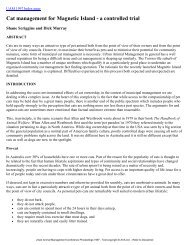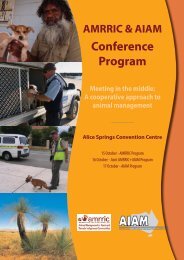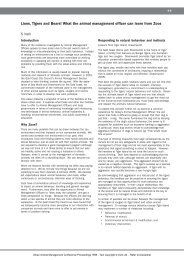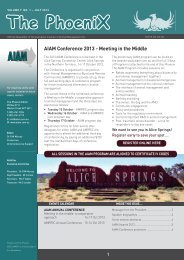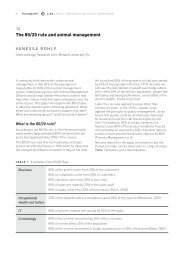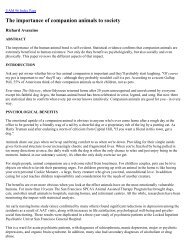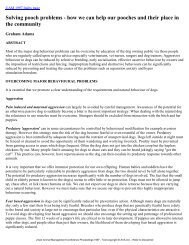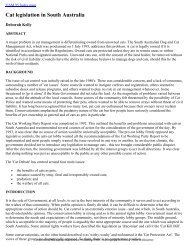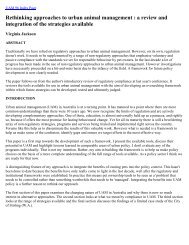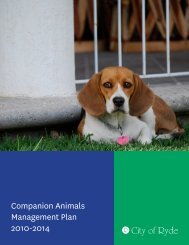Proceedings OF ThE - Australian Institute of Animal Management Inc
Proceedings OF ThE - Australian Institute of Animal Management Inc
Proceedings OF ThE - Australian Institute of Animal Management Inc
You also want an ePaper? Increase the reach of your titles
YUMPU automatically turns print PDFs into web optimized ePapers that Google loves.
Annual Conference on <strong>Animal</strong> <strong>Management</strong> AIAM <strong>Proceedings</strong> 2012 49<br />
integral to the fabric <strong>of</strong> communities: their health<br />
is intrinsically linked to the health and overall wellbeing<br />
<strong>of</strong> the community. Therefore, a wholistic, ‘one<br />
health’ approach is required to achieve change in<br />
improvements in the health and control <strong>of</strong> animals.<br />
In any Aboriginal community, remote or urban,<br />
companion animal welfare and control can be<br />
viewed as either a “top-down” approach i.e. where<br />
decisions are made by extra-community employees<br />
and imposed on communities or a “bottom up”<br />
approach where the community’s needs and concerns<br />
underpin the animal management strategy. Given the<br />
enormous and ongoing cost <strong>of</strong> the top-down approach<br />
many communities worldwide are looking for more<br />
sustainable and effective practices (AMRRIC 2006)<br />
as past approaches have <strong>of</strong>ten been non-progressive<br />
and disrespectful on the whole.<br />
A bottom-up approach is especially important where<br />
differing cultural values exist. Whilst it is clear that,<br />
like most people, many Aboriginal people love and<br />
value their dogs and <strong>of</strong>ten share their distress about<br />
dogs in poor condition, not all people necessarily<br />
share western cultural attitudes to animal welfare<br />
and individual responsibility to care for their animals<br />
What can seem cruel to an Indigenous person can<br />
seem normal to a western person and vice versa.<br />
Two examples: Very <strong>of</strong>ten we hear ‘let him die<br />
natural way’ in response to an old diseased dog<br />
that a western eye might think would be kinder to<br />
euthanase. This is a challenging situation for any nonindigenous<br />
person working in a community (Donelan<br />
2006). Cultural attitudes and beliefs may underlie this<br />
attitude. This wish must be considered should the<br />
Veterinarian or <strong>Animal</strong> <strong>Management</strong> Worker/Officer<br />
wish to continue building a trusting relationship that<br />
allows further work to be undertaken to improve<br />
animal welfare in that community. A palliative<br />
approach might gain more cooperation in the first<br />
instance, allowing a relationship to be built in which<br />
discussion <strong>of</strong> euthanasia can take place. Another<br />
example from the other perspective is keeping dogs<br />
locked alone in backyards: to some people this is<br />
incredibly cruel, whereas it is the norm in most<br />
urbanised areas (Donelan 2006).<br />
In Aboriginal communities in particular, animal<br />
health, welfare and control tactics dictated by external<br />
forces using non-negotiated methodologies have been<br />
uniformly unsuccessful and unsustainable. Imposition<br />
<strong>of</strong> welfare and control measures, in the absence <strong>of</strong><br />
trust, relationship, adequate capacity building and<br />
two-way education and awareness programs has<br />
resulted in unnecessary ongoing expenditure on pure<br />
service delivery, both veterinary and law enforcement,<br />
and has also been demonstrated to be a completely<br />
unsustainable model. Understanding Aboriginal and<br />
Torres Strait Islander people’s different perspectives<br />
on family responsibilities and roles <strong>of</strong> dogs is crucial<br />
to delivering culturally sensitive programs in remote,<br />
rural and urban areas.<br />
Perspectives on companion animals<br />
Some differences in perspectives on normal mores<br />
for dogs in communities may have originated from<br />
the different traditions <strong>of</strong> living with canines in<br />
either culture. In contrast to the Euro-<strong>Australian</strong><br />
tradition, Indigenous <strong>Australian</strong> societies traditionally<br />
lived with dingoes brought in as pups from the wild<br />
(Corbett 2001). Dingoes are self-reliant, hunted for<br />
their food and <strong>of</strong>ten contributed their hunt to their<br />
companion Aboriginal family. They needed to be free<br />
roaming to fulfill this role. Domestic dogs, on the<br />
other hand, are almost completely dependent on<br />
human carers for food and water (Boitani et al 1995).<br />
Also, dingo breeding only occurred in the wild, and at<br />
much reduced rate compared to our domestic dogs<br />
that are capable <strong>of</strong> replacing 70% <strong>of</strong> their numbers<br />
every year (Matter and Daniels 2000). Despite these<br />
differences, canine companions had, and do still<br />
have, important roles as companions and protectors<br />
(Hunt 2006).<br />
It is not only the breed <strong>of</strong> dogs that have changed. The<br />
wider social context must be considered. European<br />
settlement brought displacement from homelands<br />
and economies, and institutionalization further led to<br />
a chronic disempowerment <strong>of</strong> people. Roaming dogs,<br />
together with this disempowerment has underpinned<br />
a common perception/ misconception that some<br />
Aboriginal people do not care about their dogs,<br />
whereas in fact, on the whole, they do. Dr Sophie<br />
Constable’s research confirms this fact (Constable<br />
et al 2008) demonstrating that Aboriginal people<br />
keep pets for many <strong>of</strong> the same reasons as non-<br />
Indigenous people. Companionship is the key reason<br />
for people to keep dogs, cats or pigs and interactions<br />
between them and their owners are <strong>of</strong>ten<br />
affectionate or sometimes cruel as in any developed<br />
society. Whilst dogs everywhere can be part <strong>of</strong><br />
human families, in some Indigenous communities<br />
this is recognized in a formal way by including dogs in<br />
the kinship system. Dogs can also serve a practical<br />
purpose by assisting in hunting (Donelan 2006) and<br />
are <strong>of</strong>ten seen as ‘protectors and guardians, both <strong>of</strong><br />
property in a territorial sense but also in a spiritual<br />
sense: to ward <strong>of</strong>f evil spirits.<br />
“Dog Dreaming” is a very real and an important<br />
feature <strong>of</strong> dog ownership and treatment within many<br />
Aboriginal and Torres Strait Islander communities. To<br />
overlook or dismiss this issue at a community level is<br />
firstly disrespectful and ignorant and secondly, can<br />
result in significant noncompliance with by laws or<br />
imposed plans in many communities.



